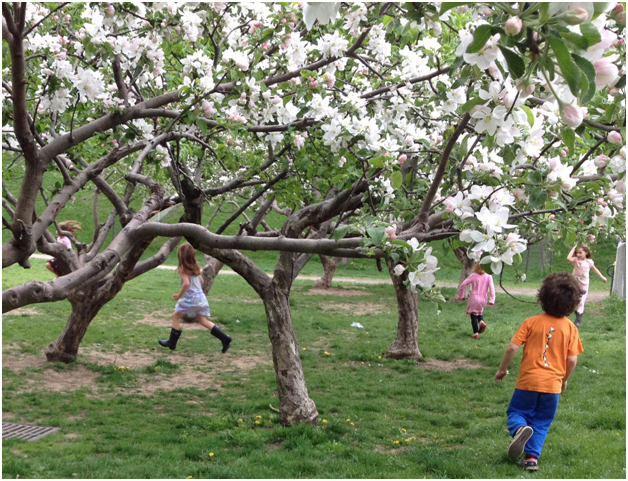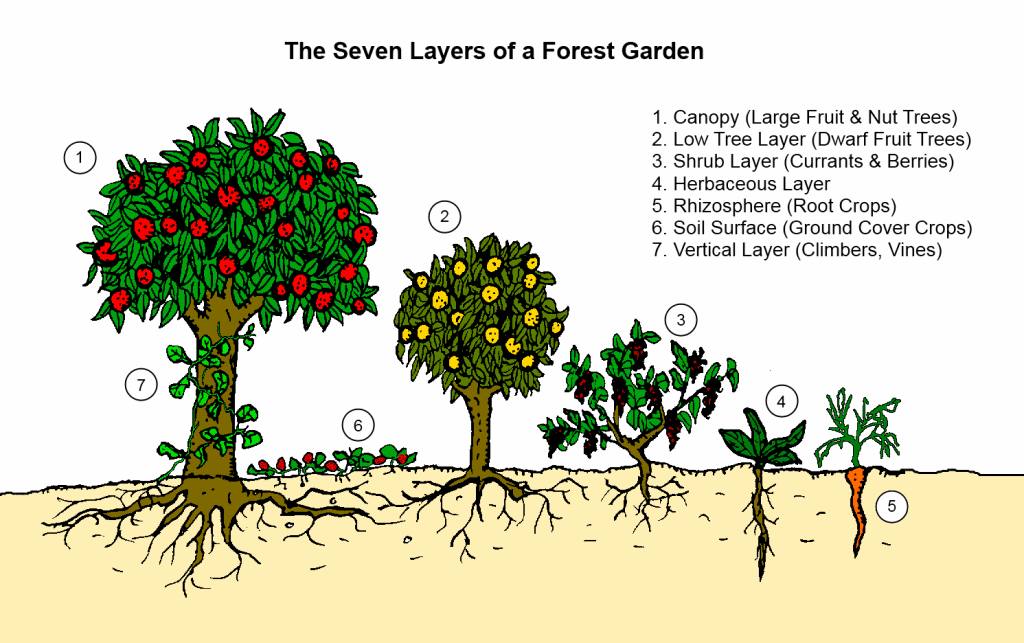Our Vision and Mission
 Edible Trails’ vision is of our human and ecological community enjoying the benefits of public edible forests along miles of trails and on acres of tribal, conservancy, schoolyard, and park lands.
Edible Trails’ vision is of our human and ecological community enjoying the benefits of public edible forests along miles of trails and on acres of tribal, conservancy, schoolyard, and park lands.
Edible Trails’ mission is to engage, educate, and support a network of youth, volunteers, organizations, and businesses to establish public edible forests in the Grand Traverse region and beyond. Our education program guides local youth to lead the process, growing plants from seed in school greenhouses, and planting and tending the forests.
Edible forests are perennial ecosystems full of a large diversity of fruits, nuts, herbs, vegetables, and wildflowers. Once established after 2-3 years, forest maintenance becomes minimal or can be discontinued altogether. Species selection starts with Michigan natives and expands to include hardy edible and medicinal perennial plants. Plants and their uses are labelled. The benefits of public edible forests include:
- An abundance of healthy free food for generations of people
- Improved ecosystem health, with more native plants, biodiversity, wildlife and pollinator habitat, healthier soil, cleaner water and air, and sequestered carbon
- Direct educational experience with plants, ecology, and agriculture for the public
Who We Are
The Edible Trails Project is a network of organizations and volunteers cooperating to transform our unused public spaces into edible forests. Crosshatch Center for Arts & Ecology (formerly known as ISLAND) is Edible Trails’ fiscal sponsor, and our partners include:
SEEDS, TART Trails, Archangel Ancient Tree Archive, TBAISD’s Career Tech Center, Greenspire School, Children’s House Montessori, the Grand Traverse Band of Ottawa & Chippewa Indians’ Natural Resources Department, Traverse City High School, Perennial Harvest, Realeyes Homestead, NoMi Forager, and the Grand Traverse Mycological Society,
Video donated by Jones Studio LLC of Suttons Bay in June 2015
Our History
Edible Trails started in 2014 when a group of Traverse City area residents began meeting to plan edible forests gardens along the trail. The project was started by AmeriCorps VISTA Jonathan Aylward, Samantha and Christopher Graves of Healing Tree Farm at DeYoung, Levi Meeuwenberg of Realeyes Homestead, and Stuart Campbell of Perennial Harvest. Over the course of months, the group collaboratively designed two public forest gardens. After a winter of planning, the proposal was enthusiastically received by Tart Trails Inc. and the Leelanau Conservancy, whose land would host the gardens.
We launched a successful crowdfunding campaign to kick off the project in May, 2014. Thanks again to everyone who donated! We planted the two food forests that fall and in spring of 2015.
Also in 2015, Edible Trails worked closely with SEEDS to plant edible forests at their host schools. We also established a plant nursery at the SEEDS Farm in Historic Barns Park, and planted two addition gardens at the Caboose on the Leelanau Trail, and in front of the SEEDS Farms.
In 2016, Edible Trails has been working with the TBAISD’s Career Tech Center, Greenspire School, and Children’s House Montessori to grow plants for the nursery, which will soon be big enough to be planted on the trail. Volunteers and classrooms have been maintaining the food forests. Edible Trails continues to work with partners throughout the region to establish public edible forest gardens.
Since our crowdfunding campaign, we’ve received grants from Rotary Charities, Rotary Sunrise Club, and the United Way. Thank you to these organizations!
Get in touch if you’d like to be involved or would like to partner to plant a new site!
American Persimmon (photo by Oikos Tree Crops) and Pawpaw are two often forgotten delicious native Michigan fruit trees.
Press
- Cherryland Electric Cooperative, 5/10/16: https://cherrylandelectric.coop/2016/05/fast-food-trail/
- Grand Traverse Insider, 5/27/15: http://www.morningstarpublishing.com/articles/2015/05/27/grand_traverse_insider/news/grand_trave
- Edible Grande Traverse, Spring 2015: http://onlinedigeditions.com/publication/index.php?i=&m=10551&l=1&p=43&pre=&ver=swf
- eatdrinkTC: http://eatdrinktc.com/creating-a-food-forest-in-traverse-city/
- Record Eagle: http://www.record-eagle.com/news/local_news/food-forest-to-sprout-along-tart-trail/article_9fcabf8e-f9c9-550b-b5f0-cb43f7247abd.html
- My North: http://mynorth.com/2014/05/help-to-fund-the-grand-traverse-edible-trails-project/
- Sustainable TC: http://www.sustainabletc.com/2014/05/28/edible-forest-project-midnight-deadline/
- Up North Live: http://www.upnorthlive.com/community/press_release.aspx?id=1047803
What is Forest Gardening?
“Picture yourself in a forest where almost everything around you is food. Mature and maturing fruit and nut trees form an open canopy. If you look carefully, you can see fruits swelling on many branches—pears, apples, persimmons, pecans, and chestnuts. Shrubs fill the gaps in the canopy. They bear raspberries, blueberries, currants, hazelnuts, and other lesser-known fruits, flowers, and nuts at different times of the year. Assorted native wildflowers, wild edibles, herbs, and perennial vegetables thickly cover the ground. You use many of these plants for food or medicine. Some attract beneficial insects, birds, and butterflies. Others act as soil builders, or simply help keep out weeds. Here and there vines climb on trees, shrubs, or arbors with fruit hanging through the foliage—hardy kiwis, grapes, and passionflower fruits. In sunnier glades large stands of Jerusalem artichokes grow together with groundnut vines. These plants support one another as they store energy in their roots for later harvest and winter storage. Their bright yellow and deep violet flowers enjoy the radiant warmth from the sky. This is an edible forest garden.” (by Dave Jacke and Eric Toensmeier, EdibleForestGardens.com)

“Edible forest gardening is the art and science of putting plants together in woodland-like patterns that forge mutually beneficial relationships, creating a garden ecosystem that is more than the sum of its parts. You can grow fruits, nuts, vegetables, herbs, mushrooms, other useful plants, and animals in a way that mimics natural ecosystems. You can create a beautiful, diverse, high-yield garden. If designed with care and deep understanding of ecosystem function, you can also design a garden that is largely self-maintaining. In many of the world’s temperate-climate regions, your garden would soon start reverting to forest if you were to stop managing it. We humans work hard to hold back succession—mowing, weeding, plowing, and spraying. If the successional process were the wind, we would be constantly motoring against it. Why not put up a sail and glide along with the land’s natural tendency to grow trees? By mimicking the structure and function of forest ecosystems we can gain a number of benefits.” (by Dave Jacke and Eric Toensmeier, EdibleForestGardens.com)
Food Forests in History
“On the banks and round about the clusters of timber there is an infinite number of fruit trees, chiefly plums and apples. They are so well laid out that they might be taken for orchards planted by the hand of a gardener.
On all sides the vine is seen; there are with some bitter and rough grapes, – others whose berries are extremely large and plump. There are also white and red grapes, the skins of which are very thin, full of good juice.
I have observed there nearly twenty different kinds of plums. The apples are of medium size… There is also a number of cherry-trees… In places there are mulberry trees which bear big black mulberries; this fruit is excellent and refreshing. There is also a very large quantity of hazel nuts and filberts. There are six kinds of walnuts…. There are also stretches of chestnuts, chiefly towards Lake Erie. All the fruit trees in general are loaded with their fruit.”
New public forest gardens are popping up all over the world. Seattle’s Beacon Food Forest sent ripples of inspiration around the country a couple of years ago, and many are being born each year. Together we are reintroducing the public edible woodland.








